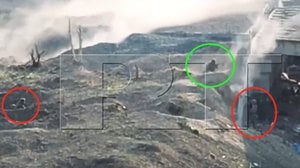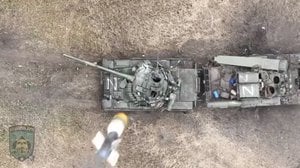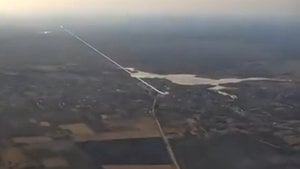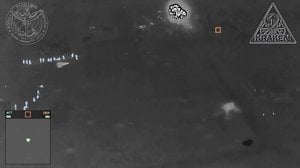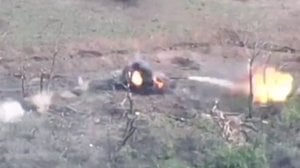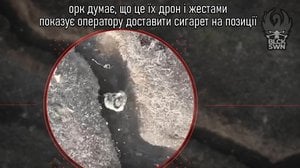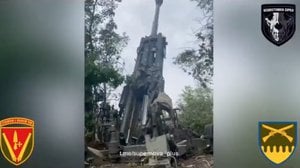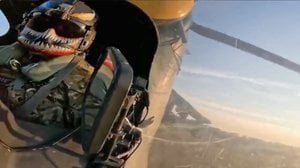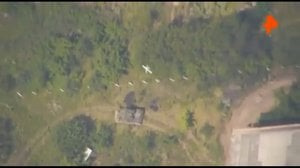
Ukrainian Spots Russian in the Prone and Shoots Him
Published 1 years ago
Interesting cell phone footage released by a Ukrainian Soldier captures the screams of a distant Russian Soldier after the Ukrainian opens fire on him, highlighting one major issue with combat footage that is discussed in the analysis tab of this video.
For the purpose of context before I get on my soap box, this footage was posted by a Ukrainian Soldier who has dominantly been posting footage from the Bakhmut region of Ukraine. That does not mean that this footage was filmed in Bakhmut, as no specific location was posted with it, but the troop has been located there for the past few months so it's safe to assume that this footage is from that region.
I am now going to ramble about combat footage in general for a minute, and you're just going to have to live with it. This is a totally unedited and unfiltered rant off the top of my head based on my experience as someone who has both logged thousands of hours of actual combat operations in Iraq and Afghanistan and additionally tens of thousands of hours of watching, documenting, and writing about combat footage over the last two decades. If at any point this seems disjointed or stops making sense, it's because I just typed. Typos are owned by me, and you'll have to get over it. This is a blog, not a professional submission or news article on the subject. I have no editor unless Funker or one of the guys comes back through here and cleans this up later on their own.
Let's talk about the inherent problems with combat footage and viewing war through a 3rd party lens attached to a front-line Soldier. First and foremost, the obvious problem is that cameras are not as good as our MK 1 eyeballs, and likely it will be a long time before they are, if they ever get there at all. We live a in a multi-dimensional world and have five basic human senses that allow us to interface with our environment. A camera captures two of those senses, sound and sight, and allows our brains to interpret the other three senses however we see fit. This obviously leads to differing opinions on situations as every 3rd party viewer of the footage has lived their own life as the main character, and they have not lived through this one individual's exact recorded scenario.
In this video, we know that the Ukrainian Soldier is aiming his rifle at the prone position of a Russian who is trying to remain concealed. We know this because the Ukrainian says it, and we can audibly hear the Russian he claims to be aiming at screaming after the shooting starts. What we can't do is see that Russian Soldier laying in the prone position, which makes it easy for one side of the party to look at this video and claim that it's fake since the primary sense in which we interface with combat footage doesn't overtly show the Russian Soldier in plain view at a cursory glance on the first view-through of the footage.
This gets much deeper however, as video itself outside of the five major senses we live and interface with day-to-day can and never will show the full picture. It will always be a two dimensional image of a four dimensional world that leaves out important context cues including the time that takes place before and after the camera stops rolling. This time before and after the MP4 file is easily just as important as the seconds and minute contained with in, and we will never see it because that moment in time was never captured. It's easy to draw conclusions ourselves from this end, but most likely we'll be missing a large portion of the picture unless we're able to sit down with the person who filmed the footage and get the full context of each recorded second, as well as the moments before and after the footage has concluded. This is often why officers will start recording an interaction minutes before an engagement with someone, and for hours after an officer involved shooting has taken place.
Essentially, what I'm getting at is that combat footage itself will never be able to truly show us the reality of life in a war zone or in a second-to-second combat situation. We may see small snippets of combat action, but we'll never get the full experience of war simply from hours of combat footage. While there is historical importance to this footage that can and will live on forever, it's not a substitute for seeing it yourself. It may help individuals re-live parts of their lives and in turn help them cope with traumatic experiences as well from seeing that others have had a similar experience to themself, but it will never be a proper substitute for living a situation, and it can and never will give us the full context of the moment unless the perspective of the person recording is also properly logged by written word or audio recording.
On top of this, combat footage in the current world presents other problems as well. With the rise of artificial intelligence and deepfake technology, we have seen dozens of instances already in just this conflict of 100% fabricated footage being shared to show victories on either side of the Russo-Ukraine war. This stems from DCS footage being routinely passed off as combat flight operations at the beginning of the war to more recently where artificial intelligence was used to show destroyed American combat vehicles inside of Russia where none were actually present. I fear greatly that this technology will be used more in the future and could potentially even insight further violence around the world, as there is not a damn thing stopping bad-faith actors from using this technology with evil intent.
So yes, before you go down in the comments and complain that you can't see anything, just know that I don't really care what you can and can't see or what you do and don't believe about the footage you're watching. The only opinions and perspectives that matter to this specific video is the Ukrainian who filmed it, the guys sitting in the fighting hole with him, and the Russian Soldier who can be heard screaming on the other end of the camera. Even my opinion on the subject is next to worthless in reality, and I just wrote all of this because it's the random thought that popped into my head while viewing this video.
Apologies for the rant, but thanks for coming to my off the cuff TED Talk. Have a nice day.
About the Author

Josh Brooks
Josh is an American writer and former USMC machine gunner with eight years of experience in ground combat arms throughout the GWOT. He is currently based in Texas and specializes in combat footage analysis and digital marketing.Follow Josh at OfficialJoshBrooks.com


